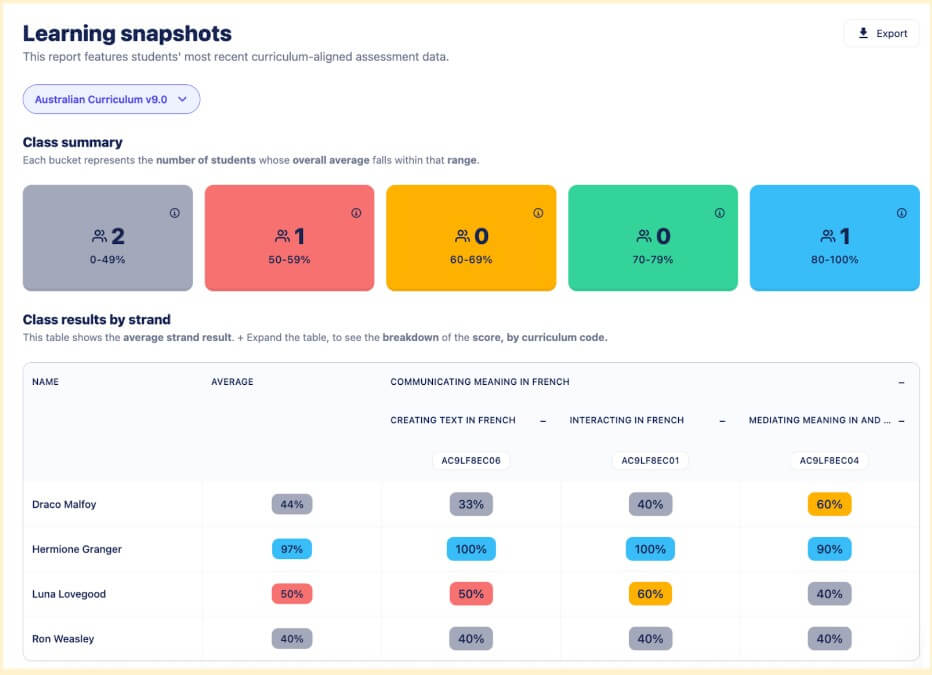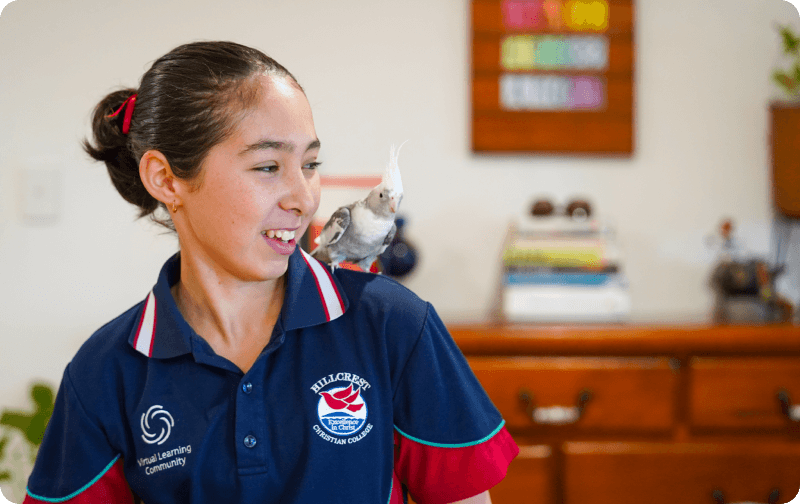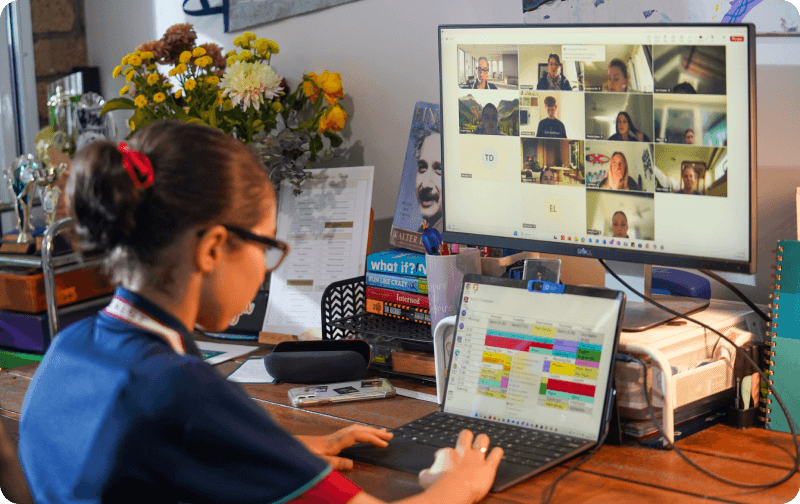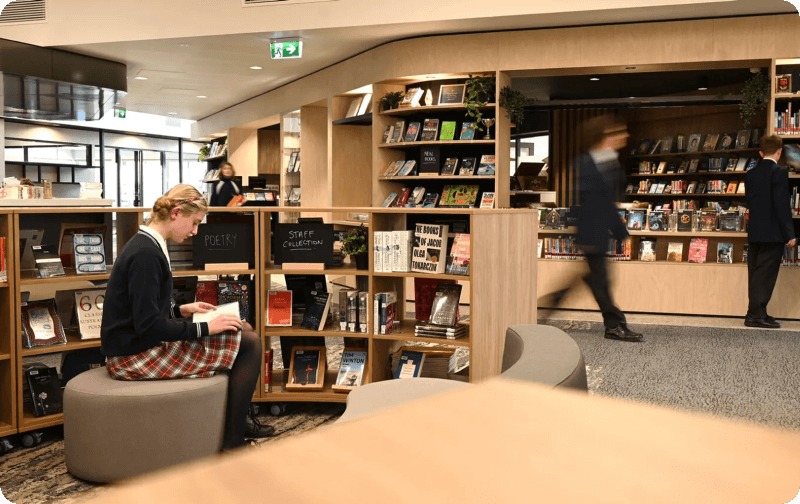But it’s not just speaking. Teachers also grapple with aligning assessment with what truly engages students, managing increasingly diverse and mixed-ability classrooms, and providing timely feedback that genuinely reflects growth.
A growing number of educators are finding ways to transform assessment into something more supportive, inclusive, and reflective of real-world language use. Here’s how you can make assessment a tool for growth and celebration rather than anxiety.
1. Embrace frequent, low-stakes assessment
Breaking large, end-of-term exams into smaller, ongoing tasks shifts the focus from a single “make or break” moment to continuous learning. Students have more chances to demonstrate their skills and are less likely to freeze under pressure.
“We’ve removed all of those high-stakes moments… and made assessment feel more like practice rather than performance.” – Janet Schneider, Head of Languages at Brisbane State High School.
2. Value progress over perfection
The pressure to be perfect and accurate often overshadows the value of progress. Progress in language learning is often gradual, so it’s vital to acknowledge and celebrate small wins. By focusing on improvement rather than flawless output, students feel encouraged to take risks and persist.
3. Build portfolios of work
A portfolio offers a richer, more holistic picture of student learning over time. It can include speaking recordings, writing samples, listening activities, and vocabulary checks, giving students ownership over their progress.
“Seeing a collection of work allows for a clearer picture of overall understanding beyond a single grammar point.” – Amanda Kennedy, Senior Languages Teacher at Kelvin Grove State College.
4. Foster student agency and choice
When students have a say in their assessment, engagement increases. This could mean selecting from a choice of tasks, revisiting work to improve it, or engaging in self-assessment.
“It’s about students reflecting on their own process and challenging themselves.” – Manon Poirier Ruaudel, Languages Teacher at Newington College.
5. Leverage technology for seamless integration
Digital tools can make assessment more interactive and accessible, from voice recordings for speaking tasks to auto-marked quizzes for quick checks. They also give teachers valuable data to personalise learning.
6. Encourage self-reflection – for students and teachers
Self-assessment helps students set goals, recognise their progress, and take ownership of their learning. For teachers, reflection on assessment data can guide the next steps in teaching and curriculum design.
“It is determining the next steps in that process of our teaching and learning too.” – Lale Arbabzadah, Languages Teacher at Newington College.
Conclusion
By making assessment continuous, authentic, and student-centred, you can help learners see it as an integral part of the learning journey, not a stressful hurdle to overcome. Frequent, low-stakes tasks, a focus on progress, and the thoughtful use of technology can transform the experience, creating classrooms where students feel confident, empowered, and eager to continue their language learning.
“We have students even as of this week emailing me to make a change back into languages. So super pleased.” – Janet Schneider, Head of Languages at Brisbane State School.
And by re-thinking assessment, you’re not only easing the pressure of assessment but also tackling the bigger challenges: keeping students genuinely engaged, supporting diverse and mixed-ability classes, and delivering feedback that reflects real growth.
]]>At Education Perfect, we think about the needs of language teachers in terms of: Instruction, Assessment, and Practice. Each with sub-themes that reflect real classroom needs, specific to the language teaching learning process.
This guide will help you evaluate your tooling needs based on how well supported you are in these three categories, as well as help you compare usability, integration, security, and impact for any tools you use or select.
Part 1: Supporting Each Phase of the Language Learning Cycle
 1. Instructional Support
1. Instructional Support
|
What to Look For |
Why It Matters |
How Education Perfect Delivers |
|
|
Support for course planning |
|
Supports faculty collaboration and planning |
Teachers can use EP’s course planner tool to align EP resources to curriculum goals and your scope and sequence |
|
Support for explicit teaching |
|
Enables clear, direct instruction |
EP includes engaging tools for introducing new vocabulary and language patterns including interactive thinglinks, videos, native speaker audio and scaffolded activities |
|
Targeted instruction tools |
|
Enables personalisation without extra work |
EP auto-groups students based on diagnostic and task data and provides learning recommendations |
 2. Assessment Capabilities
2. Assessment Capabilities
Great assessment tools inform language instruction—not just report outcomes.
|
What to Look For |
Why It Matters |
How Education Perfect Delivers |
|
|
Readiness diagnostics |
|
Supports planning and intervention |
EP’s Smart Diagnostic tests identify readiness for learning and misconceptions |
|
Formative assessment tools |
|
Helps adjust teaching in real time |
EP shows who’s stuck, who’s guessing, and who’s succeeding—instantly |
|
Summative assessments |
|
Tracks mastery and accountability |
EP includes curriculum aligned reporting and ‘compare pre-post test’ functionality |
 3. Practice & Revision Support
3. Practice & Revision Support
Consolidation is where deep learning happens—and where digital tools can really shine.
|
What to Look For |
Why It Matters |
How Education Perfect Delivers |
|
|
Guided practice tasks |
|
Supports skill and topic mastery |
EP offers scaffolded lessons/activities with hints and help built in |
|
Independent practice |
|
Builds fluency at a personalised pace while maximising student engagement |
EP supports self-paced learning with teacher oversight as well as offers competitions, leaderboards, multi-media integrations and interactive content |
|
Revision & exam prep |
|
Focuses student effort where needed Builds confidence ahead of high-stakes assessments |
EP generates revision based on assessment or activity data EP includes revision modes, quizzes, and practice exams |
Part 2: What to expect from any EdTech provider
Whether you are taking advantage of a single tool to support the whole teaching and learning cycle, or using multiple tools to support different areas, there are several boxes that must be universally ticked.
 1. Teacher Usability & Department Collaboration
1. Teacher Usability & Department Collaboration
A platform only works if teachers want to use it—and can do so with minimal friction.
|
What to Look For |
Why It Matters |
How Education Perfect Delivers |
|
|
Intuitive teacher dashboard |
|
Reduces training time and improves adoption |
EP offers a user-friendly interface and personalised onboarding support |
|
Smart task assignment |
|
Saves time for teachers, especially under pressure |
EP lets teachers assign by topic, skill, student group or diagnostic data |
|
Live analytics |
|
Helps prioritise class and individual support |
EP shows live performance and progress across tasks, topics, and time |
|
Collaboration tools |
|
Supports department planning and alignment |
EP enables easy content sharing and cross-class tracking |
|
Customisation options |
|
Teachers can align their tools to their practices and class needs |
EP offers customisable content, ability to create your own content and is flexible to integrate into different teaching practices |
 2. Integration & Technical Setup
2. Integration & Technical Setup
If it’s not easy to integrate, it won’t get used.
|
What to Look For |
Why It Matters |
How Education Perfect Delivers |
|
|
LMS integration |
|
Avoids double-handling and reduces admin |
EP integrates with major LMS platforms |
|
Single Sign-On (SSO) |
|
Reduces login friction and IT support issues |
EP supports many options including Google and Clever |
|
Data syncing |
|
Ensures up-to-date classes and data |
EP supports CSV, MIS and third-party integrations |
|
Device compatibility |
|
Works reliably in all classroom environments |
EP works on Chromebooks, iPads, PCs, tablets |
 3. Data Privacy, Security & Compliance
3. Data Privacy, Security & Compliance
Especially for student data, trust and transparency are non-negotiable.
|
What to Look For |
Why It Matters |
How Education Perfect Delivers |
|
|
Compliance certifications |
|
Required for ethical and legal use |
EP holds certifications in ST4S, ISO, Student Privacy Pledge and more |
|
Secure logins |
|
Protects student identity and access |
EP uses encrypted logins with SSO support |
|
Transparent data use |
|
Builds trust with parents and staff |
EP never shares or sells student data |
|
Data export & deletion |
|
Required for compliance and cleanup |
EP provides full control over school-held data |
|
Server security |
|
Protects students, teachers and your school |
EP uses AWS Cloud Sydney and adheres to their stringent security measures |
Learn more about Education Perfect’s comprehensive security & privacy measures here.
 4. Evidence of Impact
4. Evidence of Impact
Choose a tool with a proven track record—not just nice features.
|
What to Look For |
Why It Matters |
How Education Perfect Delivers |
|
|
Efficacy studies |
|
Build confidence your investment will drive impact on student results |
All EP content is designed by a team of Languages experts and is based on learning science. EP has produced several ‘Evidence Of Impact’ studies. |
|
Accredited learning design |
|
Ensure quality and depth of content |
EP holds the Digital Promise Product certification and Efficacy Bronze certificate for Real Result. Our research has also been independently validated by John Hopkins University. |
|
Independent case studies |
|
Validates effectiveness in classrooms |
EP has case studies showing growth in student performance and engagement. |
|
Positive teacher feedback |
|
Reflects adoption and impact |
91% of teachers report EP improves lesson efficiency and insight. |
|
Student engagement metrics |
|
Correlates with sustained impact |
Students regularly engage with EP in and beyond class time. |
|
Supports all learners |
|
Ensures equity and challenge |
EP adapts to high-performers and supports intervention needs equally. |
Learn more about the impact of Education Perfect see our here.
 5. Cost, Value & Licensing
5. Cost, Value & Licensing
A smart investment is scalable, sustainable, and proven to deliver value.
|
What to Look For |
Why It Matters |
How Education Perfect Delivers |
|
|
Transparent pricing |
|
No hidden costs or confusion |
EP offers clear per-student or site-wide licensing. |
|
Subscription tiers to suit your needs |
|
Find a tailored solution to meet your departments needs & budget |
EP offers several subscription tiers to support different schools’ needs. See more detail here. |
|
Flexible implementation |
|
Tailored to your department’s scale |
EP can be trialled in a year group or school-wide. |
|
ROI metrics |
|
Supports leadership buy-in |
EP schools report improved student outcomes and workload reduction. |
|
Free trials |
|
Ensures confident decision-making |
EP offers guided pilots with support and training included. Register for your free trial here. |
 Summary
Summary
 If you are looking to streamline your investment in tools and resources to support language teaching and learning, look for platforms that can support your educators across all phases of the learning cycle.
If you are looking to streamline your investment in tools and resources to support language teaching and learning, look for platforms that can support your educators across all phases of the learning cycle.
|
Education Perfect |
Textbooks |
Revision tools |
Quiz tools |
Diagnostic assessment tools |
|
|
Course planning |
|
||||
|
Explicit instruction |
|
|
|||
|
Targeted instruction |
|
|
|
||
|
Readiness assessment |
|
|
|||
|
Formative assessment |
|
|
|
||
|
Summative assessment |
|
|
|||
|
Guided practice |
|
|
|||
|
Independent practice |
|
|
|
||
|
Exam prep & revision |
|
|
|
|
|
 Every tool in your toolkit should offer high quality features & content and deliver impact.
Every tool in your toolkit should offer high quality features & content and deliver impact.
No matter what your tool[s] of choice support, you should also consider their strength in the following:
|
Education Perfect |
|
|
Deep curriculum-alignment |
|
|
Intuitive interface |
|
|
Time-save features such as auto-marking |
|
|
Evidence of impact |
|
|
Easy integration options (LMS integration/SSO) |
|
|
Real time analytics |
|
|
Compliance certifications |
|
|
Teacher onboarding |
|
|
Flexibility & customization options |
|
 Final thoughts for department heads and school leaders in Languages
Final thoughts for department heads and school leaders in Languages
Your role is to lead strategy, not just chase tools. Prioritise platforms that can:
- Enable great instruction, assessment and practice
- Reduce your team’s admin load
- Help you and your teachers intervene earlier and more effectively
- Amplify the impact of the teacher not just digitise existing practices
- Deliver student results
Despite Australia’s population being made up of over 270 ethnic groups, the latest research shows only 8.6% of Year 12 students are enrolled in language studies. In an increasingly interconnected world, particularly in the Asia-Pacific region, language learning is crucial for Australia’s global competitiveness, improving communication, and ultimately driving future economic growth.
EP’s newly redeveloped Language offering is designed to help reverse this trend. Underpinned by the EP Learning cycle, the new languages offering is designed to support students’ language learning regardless of their proficiency. It is underpinned by evidence-based pedagogy and research highlighting the importance of confidence, identity and real-world context in language acquisition.
With the new offering, teachers can track students’ progress through skill snapshot assessments, offering a more nuanced and supportive view of each student’s development. These short, targeted assessments can be assigned multiple times throughout the topic to feed directly into the learning cycle.
Rather than focusing solely on memorisation, students are encouraged to move beyond the traditional core skills – reading, writing, listening and speaking – and into dynamic, scenario-based learning that builds confidence, curiosity and courage to communicate. When combined with powerful new technology, this newly developed content is a testament to where edtech platforms can make a real difference to student outcomes.
The new updates are offered in EP’s largest languages, French, Japanese, German, Spanish, Italian and Chinese. The courses feature interactive, multimodal modules that support a range of learning styles. Customisable tools and scaffolded, low-pressure activities allow students to speak and engage meaningfully with the language and reduce the fear of making mistakes.
These features help teachers personalise learning without adding extra burden, with instructional lessons that can be delivered to the whole class or completed on individual devices. Summative topic assessments and new reporting tools link directly to curriculum outcomes, giving teachers clear insight into student achievement across multiple lessons and units.
In EP’s mission to amplify the impact of teachers, specific materials and content will also be available to help teachers who may not be language specialists, so they too can still achieve a high level of impact in the classroom. EP is also introducing a new subscription tier to support schools that may not have the same access to resources and funding can utilise assessment and learning tools that make a real difference.
“Education Perfect has reimagined language learning with one clear goal in mind: to maximise every student’s potential,” said Philippa Kruger, Senior Product Manager: Global Languages at Education Perfect. “The updated languages offering is designed to arm teachers with a powerful ally in the classroom. With powerful assessments, learning snapshots, enhanced content and lessons and interactive tools, no longer do teachers need to be reliant on a breadth of tools and their own creativity, but they now have an offering to enhance the full teaching cycle.”
Amanda Kennedy, Italian Teacher, Kelvin Grove State College, said, “Trying to track multiple strands of learning for every student on paper is simply impossible. Having this clear, visual reporting—especially with the colours that instantly highlight areas of need is a game-changer. It shows me exactly who needs support, allowing me to intervene precisely and provide targeted help right when it’s needed.”

For more information, please visit: educationperfect.com
About Education Perfect:
Education Perfect (EP) is driven by the mission to maximise every student’s potential. Developed by and with teachers, EP is a complete digital learning, assessment and analytics and learning toolkit for educators, helping teachers to redefine teaching and learning experiences in line with the requirements of the 21st century.
The Education Perfect Group, combining Education Perfect, Essential Assessment and EdPotential, serves more than 5,000 primary and secondary schools and 1.8 million enrolled students worldwide.
EP is a fast-growing private equity-owned technology business and currently has a team of 250+ talented EPeeps based in New Zealand, Australia, and Canada. As a proud B-Corp certified business, EP balances being a for-profit company that is purposeful and considerate of the impact that business decisions have on its team, customers, the wider community, and the environment.
Media contact:
The PR Group
E: educationperfect@prgroup.com.au l M: +61 461 275 685
]]>Enter EdTech. Technology is revolutionising education, and for teachers in Languages Learning departments, it offers a game-changing solution to differentiate instruction effectively. Scalable, efficient, and curriculum-aligned, EdTech tools like Education Perfect (EP) are helping to meet every student’s needs, all while reducing teachers’ workloads.
In this blog, we’ll explore why differentiation in language learning is essential, the unique challenges of providing it, and how EdTech empowers educators to create personalised pathways for every learner.
Why Differentiation in Language Learning Is Crucial
Language learning isn’t one-size-fits-all. Unlike some other subjects, a learner’s starting point in a languages class can vary dramatically based on prior exposure, natural aptitude, motivation, or even cultural background.
The risks of “one-size-fits-all” lessons
Advanced learners often feel unchallenged and disengaged.
When advanced learners are not given opportunities to explore challenging material, they can quickly lose interest in their studies. A lack of intellectual stimulation may lead to boredom, frustration, and even a decline in academic performance.
These students often crave deeper exploration and opportunities to apply their knowledge creatively, but when the curriculum doesn’t meet their needs, they may disengage altogether, missing out on reaching their full potential.
Struggling students may feel overwhelmed or lost, leading to lower confidence.
For students who face difficulties keeping up with lessons, the classroom can feel like an intimidating and isolating environment.
Falling behind on concepts or assignments often creates a cycle of stress and frustration, leaving these students reluctant to participate or seek help.
Over time, this can severely impact their self-confidence, making them think they’re incapable of improving. Without proper support and encouragement, struggling students may disengage entirely, leading to a greater risk of academic failure.
What’s the solution? Differentiated instruction. By tailoring lessons to student needs, teachers can foster confidence, encourage active engagement, and help develop real proficiency.
This approach enables learners to progress at their own pace, ensuring that all students feel supported and challenged.
Common Roadblocks to Differentiation in Languages
Despite its importance, differentiation can feel like a daunting task for language teachers. Here’s why:
Limited time
With classes often under an hour in length, covering all learning objectives while offering personalised attention can seem impossible.
High teacher workload
Tracking the individual progress of 30+ students is time-intensive, especially without the right tools.
Limited opportunities for authentic practice
Students need balanced exposure to all four language domains (listening, reading, writing, and speaking)—something traditional methods often fail to address.
Over-reliance on written tasks
While essential, these often favour stronger readers and writers, neglecting oral or aural skills.
Without effective tools, these challenges make differentiation seem unattainable. But this is exactly where EdTech comes in.
Enter EdTech: Making Differentiation Doable
EdTech solutions have transformed how we approach teaching and learning. Programs like Education Perfect offer a suite of features designed to simplify differentiation in the languages classroom, delivering impactful results without overburdening teachers.
Pre-assess to Personalise
Effective differentiation starts with understanding what each learner knows from day one.
EdTech advantage
Diagnostic assessment tools, like those used in EP, quickly identify a student’s strengths, weaknesses, and gaps in knowledge. Teachers can then group students by ability level and create tailored learning paths.
Example in action
A Year 9 French class discovers that some students excel in speaking but struggle with grammar; others need foundational support in both
Assign Level-Appropriate Tasks with Ease
Differentiation requires students to work on tasks that are right for their skill level and goals.
EdTech advantage
Modern platforms allow teachers to efficiently assign customised tasks to individual students or ability groups. This ensures every learner gets what they need rather than being restricted by textbook sequences.
Example in action
Advanced students practice fluently conjugating verbs, while beginners match vocabulary with pictures.
Support All Four Language Domains
Many traditional classrooms focus heavily on writing, but effective language learning requires a balance of listening, speaking, reading, and writing.
EdTech advantage
Interactive features in tools like EP provide engaging activities across all four domains, helping students strengthen their overall language skills.
Example in action
Students listen to snippets of native speakers, record their own responses, and receive feedback on pronunciation immediately.
Real-Time Feedback and Progress Monitoring
Feedback drives progress, but providing detailed feedback manually can be a full-time job.
EdTech advantage
Automated feedback offers instant support, enabling students to learn from their mistakes immediately. Teachers can track progress and make real-time adjustments based on performance data.
Example in action
A struggling Spanish student sees where they went wrong in a listening comprehension exercise and retries with guidance, building confidence.
Empower Student Agency and Engagement
Motivation matters. When students have the freedom to practise at their own pace, revisit difficult topics, and celebrate small wins, they commit more deeply to the learning process.
EdTech advantage
EdTech utilises gamification techniques and learner autonomy to convert reluctant students into enthusiastic participants.
Example in action
A student who used to hate speaking Spanish now looks forward to gaining confidence in speaking skills in a non-threatening environment as well as the interactive games and quizzes on EP that make practising pronunciation fun.
Real Results in the Languages Classroom
Education Perfect’s impact in language learning classrooms isn’t just theoretical; it’s backed by measurable success stories. Consider Emmaus College in Melbourne, where Maria Sabo, Head of Languages, integrated EP into her department.
Here’s what Maria shared about her experience with EP:
“It started as a fun add-on, but now it is a tool we can’t do without.”
EP transformed the student experience, making lessons more interactive and engaging for junior learners while empowering senior students to take ownership of their progress.
“EP keeps students actively on task without the need for constant supervision, making the process more fun for both students and teachers.”
“It’s more engaging for junior students compared to traditional tasks like writing.”
With customisable lessons, real-time monitoring, and engaging practice tools, EP helped reduce the pressure on teachers while boosting outcomes for students.
How Education Perfect’s Learning Cycle Drives Differentiation
EP’s 3 phase Learning Cycle simplifies differentiation into a manageable, repeatable process:
Phase 1: Actionable Assessment
EP assessment capabilities make it easy for educators to understand where a student is at in their learning journey and identify and fill learning gaps.
EP tracks all student progress against specific curriculum outcomes and provides individual next-step recommendations based on timely data. This helps educators effectively target their interventions and plan for future learning.
Phase 2: Individualised Instruction
EP supports day-to-day teaching practices by providing educators with a deep library of curriculum-aligned learning and assessment content, planning tools, and student analytics designed to amplify their impact in the classroom.
All our content can be tailored to suit different teaching and learning needs. Educators can guide students through EP lessons or assign tasks directly to a whole class, small groups, or individual students to personalise instruction.
Phase 3: Purposeful Practice
EP can be accessed by students in class or at home to practice the skills they have been taught. Students stay engaged with games, multimedia activities and a suite of ways to represent their learning.
Teacher insights and tracking tools can be used to help the educator guide students on their learning journey or our instant feedback and marking tools can be used to support independent learning.
Transform Your Language Learning Classroom Today
Differentiation in the languages classroom is no longer a luxury; it’s essential. Every student deserves to feel supported, inspired, and capable of success, and with the right tools, that’s achievable.
Education Perfect empowers teachers to make differentiation scalable, efficient, and effective. Whether you’re teaching Japanese, Mandarin, French, German, Indonesian, Arabic, Italian or Spanish, it’s never been easier to cater to every student’s unique needs.
Take the first step towards transforming your classroom. Discover how Education Perfect can help your language learning program thrive, start your free trial or book a demo with us today!
]]>But what if technology could take some of the load off?
That’s where EdTech comes in. Far from being a passing trend, educational technology has revolutionised the way languages are taught. With tools like Education Perfect (EP), teachers can bring languages to life, streamline administrative tasks, and personalise lessons in ways that were previously unimaginable.
This blog explores five practical ways EdTech can energise your language lessons while giving you more time to focus on impactful teaching.
Why EdTech is Essential in Language Learning Classrooms
The landscape of language education has shifted in recent years. Traditional approaches often struggle to keep pace with today’s learners, who are highly visual, tech-savvy, and accustomed to interactive experiences.
Here are three key challenges facing language learning teachers today, and why EdTech is no longer optional, but essential:
Student Disengagement
Rote learning and outdated teaching methods often fail to capture students’ attention, leaving them bored and disconnected from the learning process. This can lead to passive participation, where students simply go through the motions without truly engaging or retaining information.
To counter this, educators need to adopt innovative, interactive approaches that make learning more dynamic and relevant to students’ lives. Incorporating technology, hands-on activities, and collaborative projects can spark curiosity and keep students actively involved in their education.
Mixed-Ability Groups
In today’s classrooms, students come from diverse backgrounds with varying levels of language proficiency and learning abilities.
Some may excel and need advanced challenges, while others require additional support to grasp fundamental concepts. This diversity makes it difficult for teachers to address the unique needs of every student without extra resources or assistance.
Differentiated instruction, small group activities, and adaptive learning tools can help bridge these gaps by providing personalized learning experiences that cater to each student’s skill level, ensuring that no one is left behind.
Demand for Real-Time Feedback
Research shows that timely, actionable feedback is one of the most effective ways to improve learning outcomes.
It helps students identify their strengths, correct mistakes, and stay motivated as they work towards their goals. However, in traditional classroom settings, providing individualized feedback to every student in real-time is a challenge due to the sheer volume of work and limited time. Leveraging technology, such as AI-driven assessment tools or apps, can ease this burden by automating feedback delivery, enabling teachers to focus on mentoring and guiding students more effectively.
EdTech addresses these challenges head-on by offering tools that enhance engagement, accommodate individual needs, and automate feedback. It’s not just a “nice-to-have” anymore; it’s a game-changer for sustainable, impactful teaching.
5 Ways EdTech Can Supercharge Your Language Lessons
1. Personalised Learning Through Diagnostics
Every student learns at their own pace. Diagnosing their readiness is a crucial first step in delivering impactful lessons.
With tools like Education Perfect, creating personalised learning pathways becomes effortless. EP’s readiness and summative assessments allow you to quickly assess vocabulary, grammar, and authentic communication and comprehension skills. Within minutes, you’ll have detailed insights into each student’s strengths and areas for growth.
Gone are the days of one-size-fits-all language lessons. With diagnostic-driven insights, you can tailor content to students’ needs, increasing their engagement and success.
2. Interactive and Multisensory Practice
Learning a language isn’t just about memorising words. It’s about mastering speaking, listening, reading, writing and communicating in authentic situations simultaneously.
EdTech platforms like EP provide an all-in-one learning experience. For example:
- Native Speaker Audio ensures authentic pronunciation practice.
- Interactive Tools for practising listening, reading, writing speaking and vocabulary and grammar.
- Speaking Exercises allow students to gain confidence in authentic communication.
By offering multisensory experiences, these platforms make language learning engaging, sticky, and fun.
3. Real-Time Feedback and Progress Monitoring
Imagine a classroom where students receive instant, meaningful feedback. With EdTech, it’s possible.
Platforms like EP provide real-time corrections, guiding students to self-correct errors faster than traditional methods allow. Meanwhile, you can monitor progress from a centralised dashboard, saving time on grading without compromising on insights.
Through EP’s “Measure” phase in the Learning Cycle, students benefit from a continuous loop of learning and improvement, allowing for noticeable progress over a short period.
4. Differentiation Made Easy
Differentiation is one of the most resource-intensive tasks for teachers. But it’s also one of the most impactful.
With EdTech, assigning tasks based on a student’s proficiency, interests, or goals takes just a few clicks. EP enables teachers to group students and assign tailored activities, whether for extra support or advanced enrichment.
This targeted approach reduces planning time while significantly increasing the impact on student outcomes.
5. Boosting Speaking and Confidence in a Safe Environment
Speaking a new language is daunting, especially when learners fear judgement from peers.
EdTech platforms like EP tackle this by providing a safe, low-pressure environment where students can practise pronunciation until they feel confident. Audio tools allow students to fine-tune their fluency while building verbal confidence. Not only does EP provide tasks focussed on pronunciation but also authentic communication speaking tasks where students practise their speaking skills in real life scenarios.
This gradual, supportive approach removes the fear of failure and encourages students to take risks.
The Education Perfect Learning Cycle
Education Perfect is built on a 3-phase Learning Cycle designed to make teaching more effective and scalable. Here’s how it works:
Phase 1: Actionable assessment
EP assessment capabilities make it easy for educators to understand where a student is at in their learning journey, identify and fill learning gaps.
EP tracks all student progress against specific curriculum outcomes and skills and provides individual next step recommendations based on timely data. This helps educators effectively target their interventions and plan for future learning.
Phase 2: Individualised instruction
EP can be used to support day-to-day teaching practices by providing educators with a deep library of a deep library of learning and assessment content which supports the curriculum, planning tools, and analytics designed to help them amplify their impact in the classroom.
All our content can be tailored to suit different teaching and learning needs. Educators can guide students through EP lessons or assign tasks directly to a whole class, small groups, or specific students to individualize instruction.
Phase 3: Purposeful practice
EP can be accessed by students in class or at home to practice the skills they have been taught. Students stay engaged with games, multimedia activities, and a suite of ways to represent their learning.
Teacher insights and tracking tools can be used to help the educator guide students on their learning journey or our instant feedback and marking tools can be used to support independent learning.
Supercharge your teaching with an assistant that’s available 24/7
If there’s one key takeaway from all this, it’s that EdTech isn’t here to replace teachers; it’s here to empower them.
The right tools, like Education Perfect, don’t just reduce workloads or improve lesson quality. They allow you to focus on what really matters—building meaningful connections with your students and fostering a love for language.
When technology works alongside educators, the possibilities for engagement, differentiation, and student success are limitless.
See how Education Perfect Can Work For You And Your Class
Are you ready to energise your language lessons and streamline your workflow? Education Perfect has all the tools you need to combine teaching expertise with cutting-edge EdTech solutions. To see how Education Perfect can support you and your students language learning, start your free trial or book a demo with us today!
]]>Language isn’t just about grammar rules or vocabulary lists; it’s about connection. The heartbeat of any language lies in its use as a tool for authentic communication. Whether it’s ordering coffee at a bustling Parisian café, presenting ideas in a professional meeting, or even sharing a laugh with new friends, real-world communication is where language truly comes alive.
However, replicating these authentic interactions has historically been a struggle in traditional classrooms. Textbook dialogues and isolated grammar exercises often fall short, leaving learners unprepared for the dynamic nature of real-world conversations.
This is where EdTech, with platforms like Education Perfect (EP), steps in to bridge the gap. EP’s Learning Cycle, and in particular its “Practical Purpose” phase, equips students with the tools to confidently apply their language skills in genuine, impactful ways.
Understanding the “Purposeful Practice” in the EP Cycle
What Is the Purposeful Practice Stage?
The “Purposeful Practice” stage of EP’s Teaching and Assessment Cycle emphasises moving beyond rote memorisation. Simply put, it’s about students using the language in meaningful, real-world contexts. This stage allows learners to step out of the theoretical framework and into real-life scenarios, where they can experiment, collaborate, and communicate with intent.
Its Role in the Broader Cycle
The Purposeful Practice stage is where all the building blocks of language learning come together. From mastering basic vocabulary in earlier stages to refining grammar, this moment bridges theoretical understanding and authentic use. It turns passive knowledge into active application, giving students the confidence to go beyond the classroom and engage with the world.
Why It Matters
This emphasis on authentic communication transforms learners into adaptable communicators, fostering their ability to think on their feet in unfamiliar settings. It also promotes cultural fluency by encouraging learners to consider context, audience, and the nuances of tone.
What Makes Communication “Authentic”?
Authentic communication mirrors the rich complexity of real-world interaction. Unlike scripted textbook exchanges, it involves unpredictability, cultural nuance, and varied responses.
Examples of Real-World Communication Tasks
Ordering Food
Learn how to navigate a menu, select items that suit your taste, and effectively communicate dietary preferences or restrictions to restaurant staff. Practice asking questions about ingredients, preparation methods, and portion sizes to ensure your meal meets your expectations.
Planning a holiday:
Learn the vocabulary and expressions you need to plan your holiday itinerary including both accommodation and activities. You will complete written and spoken activities to ensure that all aspects of your holiday are organised.
Writing Emails
Master the art of crafting professional and personal emails with the right tone, structure, and level of formality. Learn how to write clear subject lines, organize your thoughts effectively, and use proper etiquette to leave a positive impression, whether you’re emailing colleagues, clients, or friends.
The core of an authentic interaction is understanding context, purpose, and audience. Each of these elements shapes how language is used, and when woven into learning experiences, they immediately increase relevance and engagement.
How EdTech, and EP in Particular, Makes it Possible
EdTech is transforming how language is taught, and platforms like Education Perfect empower students through engaging, tailored tools. Here’s how EP makes the Practical Purpose stage come alive:
Interactive Scenarios
EP’s authentic tasks and simulations create environments where students can practise real-world interaction. For instance, they could practice booking a holiday or resolving an issue at a shop, equipping them with skills both functional and practical.
Speaking & Listening Tasks
Using voice recording tools, EP lets students speak and replay their recordings to enhance pronunciation and fluency. Coupled with native-speaker audio files, learners can fine-tune their listening comprehension and accent accuracy.
Cultural Context Integration
Language and culture are inseparable. Culture is integrated throughout the learning material. It is introduced explicitly through the introduction lessons and then integrated into the reading, listening, writing and speaking tasks. Students are encouraged to compare the target culture to their own cultures.
Flexible Differentiation
Every student learns at their own pace, and EP’s adaptive technology allows students to practise at a level suited to them. Whether they’re engaged in beginner dialogues or complex discussions, every task maintains a purposeful, real-world focus.
Feedback Loops
Real-time feedback on grammar, vocabulary use, pronunciation, and tone ensures fast improvement. Instead of waiting for corrections, learners can refine their output instantly, making progress much more efficient.
Highlighting EP Tools
EP’s scaffolded skills lessons and authentic tasks integrated throughout the lessons provide endless opportunities to practise. Teachers can also explore EP’s collaboration features, which encourage peer-to-peer feedback and group engagement.
Classroom Applications of the Practical Purpose Stage
Sample Topic Flow
Here’s how teachers can bring the Practical Purpose stage to life using EP tools:
- Warm-Up: Start with an engaging discussion or brainstorming activity related to the day’s topic (e.g., travelling abroad).
- Introduce or review: Use the introduction lesson for the topic to introduce or review the key language and expressions that students need to know to complete the task.
- Complete scaffolded skill building activities for students to build their reception and production skills in the context of the topic
- Authentic task: Students complete the EP Authentic task such as ordering food in a restaurant or planning an itinerary in Spanish.
- Reflection & Feedback: End with group feedback using EP’s peer-review system, focusing on fluency and cultural appropriateness.
Success Stories
Teachers worldwide are already seeing the impact.
“EP has removed the fear of speaking for many of my students,” says Emma, a French teacher in Sydney. “My class loves the simulations, and I’ve noticed a huge improvement in their confidence and engagement!”
Quick Tips for Maximising EP’s Potential
- Pair EP tasks with real-world projects like cultural presentations.
- Encourage students to practice authentic tasks regularly in new contexts.
- Use EP’s analytics to personalise lessons based on student progress.
The Transformative Impact on Learners
The Practical Purpose stage doesn’t just teach language; it transforms learners.
Improved Fluency
Regular practice in realistic scenarios helps students develop natural communication skills. By simulating real-life interactions such as conversations, presentations, or problem-solving situations, learners build the confidence to express themselves clearly and effectively. This consistent exposure allows them to think and respond in the target language without hesitation, making their communication more fluid and authentic over time.
Better Retention
Purposeful and strategic repetition helps students retain knowledge more effectively. By revisiting key concepts and practicing them in different contexts, learners solidify their understanding and ensure information stays with them long-term.
This approach not only strengthens memory but also encourages students to apply what they’ve learned in practical situations, reinforcing their skills with every use.
Cultural Fluency
Understanding cultural nuances goes beyond language—it deepens empathy and broadens perspectives. By learning about traditions, customs, and social norms, students gain insights into the cultural contexts of the language they are studying.
This understanding fosters respect and appreciation for diversity, helping learners connect more meaningfully with people from different backgrounds.
Real-World Readiness
Learning with a focus on practical application equips students to handle real-world challenges. Whether they need to excel in exams, confidently navigate unfamiliar cities, or thrive in international workplaces, students gain the skills needed to succeed in any global environment.
By preparing for real-life scenarios, they become adaptable, capable, and ready to achieve their goals.
Empower Your Class with Practical Purpose
Authentic communication is the heart of effective language learning, and EdTech tools like Education Perfect empower learners to engage in meaningful, real-world interactions.
With tools that simulate authentic scenarios, offer instant feedback, and adapt to individual learning levels, EP takes the authenticity gap out of the classroom and replaces it with practical purpose.
To see how Education Perfect can support you and your students language learning, start your free trial or book a demo with us today!
]]>





 Providers that offer easy ways to map department goals to their functionality & resources
Providers that offer easy ways to map department goals to their functionality & resources